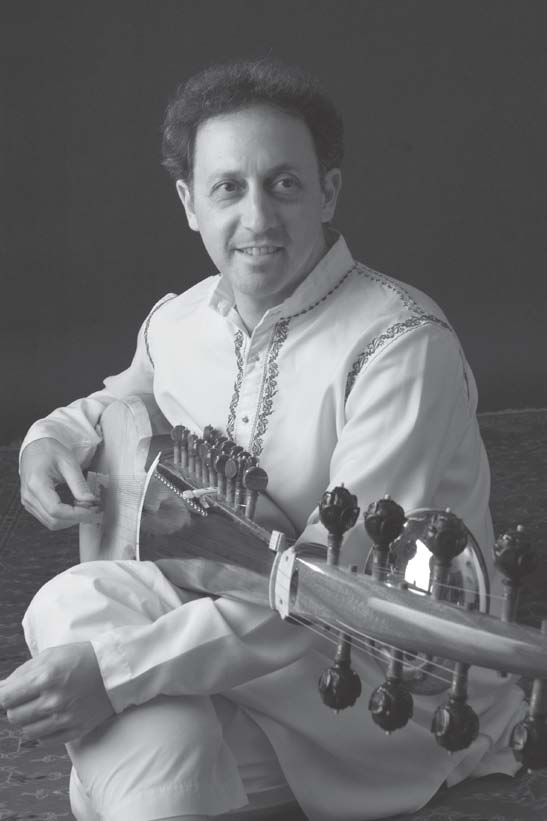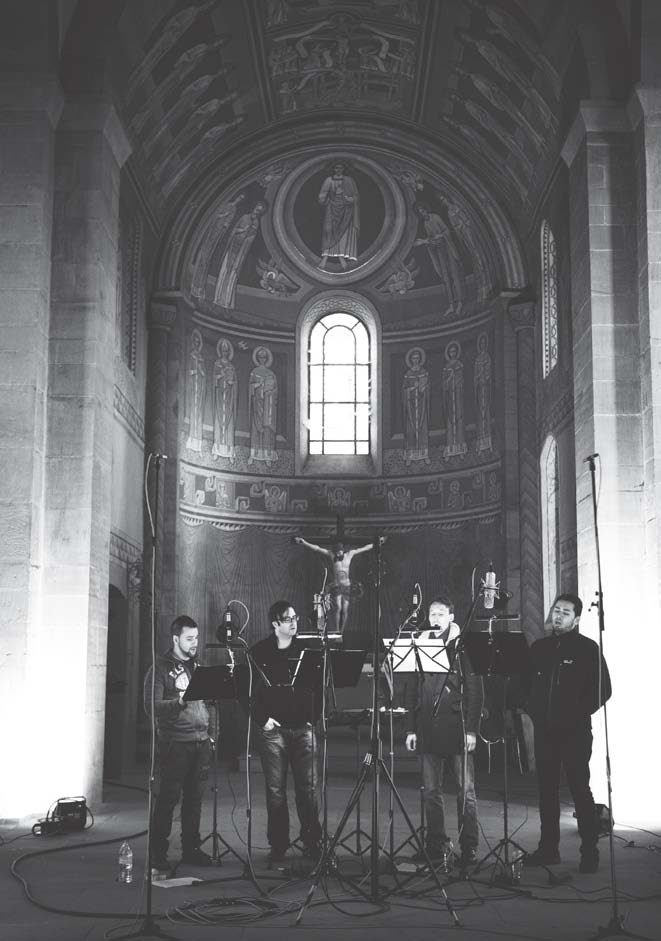Eros & Thanatos / chant1450 · Ken Zuckerman
Renaissance Love Songs & Plainchant for the Dead

chant1450.ch
kenzuckerman.com
Christophorus CHR 77397
2015
Love Songs by Juan del Enzina (1468-1529)
& Plainchant for the Dead
NOCTURNO I
1. [2:46]
Antiphon. Dirige Domine •
Sarod I •
Antiphon. Dirige Domine
2. [4:53]
Antiphon. Convertere Domine
Juan del ENZINA. Pues que jamas olvidaros
Antiphon. Convertere Domine
3. [2:28]
Antiphon. Nequando rapiat ut leo •
Sarod II •
Antiphon. Nequando rapiat ut leo
4. Ken Zuckerman.
Sarod III. Dansa desiderans [4:05]
5. Juan del ENZINA. Mi libertad en sosiego [2:09]
6. Responsorium. Credo quod redemptor [4:00]
7. Sarod IV. Qui Lazarum resuscitasti (Prelude) [0:51]
8. Responsorium. Qui Lazarum resuscitasti [2:48]
9. Juan del ENZINA. Los sospiros no sosiegan [3:29]
10. Responsorium. Domine quando veneris [6:51]
NOCTURNO II
11. [4:30]
Antiphon. In loco pascuae
Juan del ENZINA. Non quiero que me consienta
Antiphon. In loco pascuae
12. [2:12]
Antiphon. Delicta iuventutis •
Sarod V •
Antiphon. Delicta iuventutis
13. [4:52]
Antiphon. Credo videre
Juan del ENZINA. Mortal tristura me dieron
Antiphon. Credo videre
14. Ken Zuckerman.
Sarod VI. Esperanza [3:30]
15. Juan del ENZINA. Quédate, carillo, adiós [2:54]
16. Responsorium. Memento mei Deus [2:16]
17. Sarod VII. Hei mihi (Prelude) [0:51]
18. Responsorium. Hei mihi [3:39]
19. Juan del ENZINA. Razon que fuerza no quiere [3:38]
20. Responsorium. Ne recorderis [5:37]

Ken Zuckermann · Sarod
chant 1450
Javier Robledano Cabrera · Countertenor
Daniel Manhart · Tenor
Simon MacHale · Baritone
Ismael Arróniz · Bass
Mathias Spoerry · Baritone (plainchant)
Federico Sepúlveda · Baritone (plainchant)
Musical sources
Juan del Enzina (1468-1529)
- Pues que jamas olvidaros E-Mp II/1335 f. 20v-21
- Mi libertad E-Mp II/1335 f. 53v-54
- Los sospiros no sosiegan E-Mp II/1335 f. 100v-101
- Non quiero que me consienta Frottole libro secondo (Nápoles, 1516?) f. 43v-44
- Mortal tristura E-Mp II/1335 f. 33v-34
- Quedate carillo E-Mp II/1335 f. 212v-213
- Razon que fuerça E-Mp II/1335 f. 219v-220
Plainchant
E-Tc, Cantoral 110 (ca. 1545)
Historically informed performance of the spanish plainchant is based on the following sources:
Juan Bermudo, Declaracion de instrumentos musicales (Osuna, 1555)
Anónimo, Arte de melodia sobre canto lano [sic] y canto dórgano [E-Bbc ms. 1325]
Coproduction with SRF 2 Kultur
Executive producer SRF 2 Kultur: Roland Wächter
Executive producer note 1 music: Joachim Berenbold
Recording: 29.04. • 04.05 2013, 07.09.2013, Kleincomburg, Schwäbisch Hall (Germany)
Recording engineer & mastering: Roland Kupferschmied, aTonArte, Wald (Switzerland)
Editing: Daniel Manhart, Home Productions, Rapperswil (Switzerland)
Programme assistant: Juan Diaz de Corcuera
Project supervision: Esther Ineichen
Booklet editor & Layout: Joachim Berenbold
Translations: David Babcock (English) · Sylvie Coquillat (français) · Roland Wächter (Latein),
Esther Ineichen & Juan Diaz de Corcuera (Spanisch)
Artist photos: Tabea Hüberli (chant 1450), Heiner Grieder (Ken Zuckerman)
Cover picture: „Memento mori“ (ivory, 16th century), Bode Museum Berlin (Germany)
Ⓟ + © 2015 note 1 music gmbh, Heidelberg (Germany)

Eros & Thanatos
In der Ausdrucksästhetik des 19. Jahrhunderts
ist der Tod ein persönliches Drama. Von Mozarts Requiem bis zu Wagners
Liebestod deutet die Musik den Text eindringlich und persönlich, sie
macht das Schicksal des Individuums zum zentralen Thema. Ganz anders
dagegen die Haltung der Renaissance: Der Tod ist Naturgesetz. Die Musik
der Totenmessen und -offizien ist deshalb nicht „traurig“ im Sinne des
Affekts, sie ist vielmehr schlicht und schmucklos, eine Meditation über
das Sterben im Wissen, dass jedes Leben den Tod bereits in sich trägt •
ein Mantra der Betrachtung in Texten, hinter deren Wucht die Kunstgriffe
der musikalischen Konstruktion bewusst zurückstehen.
Die Frage
ist: Was soll der schwache Mensch dem Tod, personifiziert im
griechischen Gott Thanatos, entgegensetzen? Die Kirchenmusik hat im
Mittelalter die folgende Antwort darauf gefunden: ein Kunstwerk, das
durch Schriftlichkeit wiederholt werden kann als ein Versuch, das
Verschwinden aufzuheben. Einen strengen Ritus, der in klarer Form das
Hinscheiden des Menschen kommentiert, den „Allgemeinplatz Tod“
beleuchtet und sich nicht auf ein individuelles Schicksal bezieht.
Das Programm Eros & Thanatos
feiert diesen Ritus auf eigene Weise: Die historische Grundlage der
Musik ist ein Gregorianik-Manuskript, das in der Kathedrale von Toledo
(Spanien) um 1545 kopiert wurde und mit „In crastino omnium defunctorum
ad matutinum“ benannt ist. Der Titel bezeichnet ein Stundengebet „am
frühen Morgen zum Gedenken an alle Dahingeschiedenen“. Gemeint ist damit
konkret der 2. November, der Tag zu Allerseelen, an dem seit dem 11.
Jahrhundert der Toten gedacht wird. Die Texte zu dieser Matutin, dem
nächtlichen Stundengebet zwischen Mitternacht und dem Tagesanbruch,
stammen aus den Psalmen und aus dem Buch Hiob. Sie behandeln die
existenzielle Not des Menschen im Angesicht des Todes, aber auch die
Hoffnung auf Auferstehung und Erlösung. Der Ritus besteht aus drei
gleich aufgebauten „Nocturnos“, von denen die ersten beiden in diesen
Aufnahmen zu hören sind. Der Aufbau der ersten Nokturn ist im Original:
1. Dirige Domine (Antiphon 1) • Psalm 1 • Dirige Domine
2. Convertere Domine (Antiphon 2) • Psalm 2 • Convertere Domine
3. Nequando rapiat ut leo (Antiphon 3) • Psalm 3 • Nequando rapiat und leo
4. Versiculum
5. Lesung 1 • Credo quod redemptor (Responsorium 1)
6. Lesung 2 • Qui Lazarum resuscitasti (Responsorium 2)
7. Lesung 3 • Domine quando veneris (Responsorium 3)
In
die rigide Struktur der Liturgie fügt das Konzept des Programms
unerwartete Bausteine ein, die die langen, auf einem Rezitationston
gesungenen Psalmen, das Versiculum und die Lesungen aus dem Buch Hiob
ersetzen: chant 1450 singt vierstimmige Liebeslieder von Juan del Enzina (1468 • 1529), einem spanischen Dichter und Komponisten, Ken Zuckerman
improvisiert auf dem traditionellen indischen Instrument Sarod. Der
klangvolle Name dieser Laute bedeutet „Lied, Gesang, Hymne“. Wie die
Gregorianik beschränkt sich die nordindische Kunstmusik auf vielfach
differenzierte Modi (Tonleitern), die einzelnen Stücke dieses
Repertoires heissen „Raga“ und sind an eine bestimmte Emotion und
Tageszeit gebunden. Durch diese Aspekte mit der Liturgie verbunden
spielt die Sarod mit ihrem hellen Klang und dem ganzen Gewicht der
nordindinischen Musiksprache eine überraschende Rolle im Programm: Beide
Elemente • Liebeslieder und Instrumentalstücke • setzen der Matutin der
Toten die Kraft des Lebens entgegen, der Eros leuchtet im hellen
Kontrast zur kargen Thanatos-Gregorianik in der Erkenntnis, dass sich
sinnliche Liebe und körperliche Vergänglichkeit gegenseitig bedingen,
dass beide nötig sind, um den Kreis des Lebens zu schließen - die
Lebenskraft die aufstrebt, wächst und produziert und das Bewusstsein,
dass alles Leben endlich ist. Eros & Thanatos ist ein Versuch, diese
beiden Grundprinzipien in etwas Neuem zu vereinen, das Paradoxon
aufzulösen, den Todes-Ritus zu transzendieren hin zu einem
ganzheitlichen Kaleidoskop des Lebens • die neue Form dieses noch nie
dagewesenen Totengedenkens widerspiegelt
so stimmig die Haltung einer ganzen Epoche zum Sterben.
Daniel Manhart
Eros & Thanatos
In the aesthetics of expression of the nineteenth century, death is a
personal drama. From Mozart’s Requiem to Wagner’s Liebestod, the music
interprets the text insistently and personally, making a central concern
of the individual’s fate. The attitude of the Renaissance is completely
different: death is a law of nature. The music of the Requiem Mass and
Offices of the Dead, therefore, is not “sad” in the sense of emotion,
but is rather plain and unadorned • a meditation on dying in the
knowledge that each life already contains death within itself • a mantra
of contemplation in texts consciously backed up with the impact of
musical construction.
The question is: with what should the weak
human being oppose death, personified in the Greek god Thanatos? Sacred
music during the Middle Ages found the following answer to this: a work
of art that can be repeated in written form as an attempt to override
the disappearance. It is a strict ritual that comments on the passing of
man in a clear form, illuminating the “commonplace of death” and not
referring to an individual fate.
The programme Eros & Thanatos
celebrates this ritual in its own way: the historical foundation of the
music is a Gregorian manuscript that was copied around 1545 in the
Cathedral of Toledo (Spain) and named “In crastino omnium defunctorum ad
matutinum”. The title designates a Liturgy of the Hours “in the early
morning in memory of all those who have passed away”. It refers
specifically to 2 November, All Souls’ Day, on which the dead have been
commemorated since the eleventh century. The texts to this Matins, the
nightly Liturgy of the Hours between midnight and daybreak, are taken
from the Psalms and the Book of Job. They are concerned with the
existential distress of mankind in the face of death, but also with the
hope of resurrection and redemption. The rite consists of three
“nocturnos” having the same structure, the first two of which can be
heard on this recording. The structure of the first nocturne is in the
original:
1. Dirige Domine (Antiphon 1) • Psalm 1 • Dirige Domine
2. Convertere Domine (Antiphon 2) • Psalm 2 • Convertere Domine
3. Nequando rapiat ut leo (Antiphon 3) • Psalm 3 • Nequando rapiat und leo
4. Versiculum
5. Reading 1 • Credo quod redemptor (Responsorium 1)
6. Reading 2 • Qui Lazarum resuscitasti (Responsorium 2)
7. Reading 3 • Domine quando veneris (Responsorium 3)
The
concept of the programme inserts unexpected components into the rigid
structure of the liturgy which replace the long Psalms sung on one
recitation tone, the Versiculum and the readings from the Book of Job: chant 1450
sings four-part love songs by Juan del Enzina (1468•1529), a Spanish
poet and composer with Ken Zuckerman improvising on the sarod, a
traditional Indian instrument. The sonorous name of this lute means
“tune, song, hymn”. Like Gregorian Chant, North Indian art music
restricts itself to a number of differentiated modes (scales); the
individual pieces of this repertoire are called “raga” and are linked to
a definite emotion and time of day. Connected with the liturgy through
these aspects, the sarod plays an unexpected role in this programme with
its bright sound and the entire weight of North Indian musical
language. Both elements • love songs and instrumental pieces • oppose
the Matins of the Dead with the power of life; Eros shines in bright
contrast to the austere Thanatos Gregorian Chant in the knowledge that
sensual love and physical transience are mutually dependent on each
other, that both are necessary in order to close the circle of life •
the life energy that aspires, grows and produces, and the awareness that
all life is finite. Eros & Thanatos is an attempt to unite
these two fundamental principles into something new, to resolve the
paradox, to transcend the rite of death towards an integral kaleidoscope
of life • the new form of this unprecedented commemoration of the dead
thus reflects, so consistently, the attitude of an entire epoch towards
death.
Daniel Manhart


